Stop it!
Jeanna Van Rensselar, Contributing Editor | TLT Feature Article June 2014
Your car’s No. 1 safety feature is more reliable than you know.
KEY CONCEPTS
•
The risk of brakes suddenly going out due to a mechanical failure is very low.
•
While disc brakes are all-around better performers, there's a good reason that drum brakes are still around.
•
Today's automotive brake linings can last 35,000 miles and more.
WOULD-BE MURDERERS CUTTING HYDRAULIC BRAKE LINES IS SOOO YESTERDAY—gone the way of unhinging wagon wheels. Today’s sophisticated hackers have the ability to infiltrate a car’s drive-by-wire computer system and cause it to crash. The systems they can cyber sabotage in this way include the engine, navigation and brakes. Criminals can do it from just about anywhere, and while they might leave cyber evidence, there are no literal fingerprints (
1, 2).
While experts agree that car cyber sabotage is possible, there are no recorded incidents. It’s far more likely that brakes will lose power because the car owner didn’t bother to replace the brake pads. Far more likely, but because of advances in brake systems, still
quite unlikely.
HOW BRAKES WORK
There are two basic types of brakes: disc brakes and drum brakes. And there are two basic substances used to transfer force from the pedal to the wheel—fluid and air. Most braking systems are, in fact, relatively simple compared with other vehicle systems. Where things get a little more complex, though, is with the type of fluid and the type of friction material used to line the brakes.
The typical automotive brake system consists of disc brakes in front and either disc or drum brakes in the rear. When the brake pedal is depressed, the pressure moves a piston in the master cylinder. This forces the brake fluid from the master cylinder through the brake lines and flexible hoses to the calipers and wheel cylinders. Since fluid cannot be compressed, pushing fluid through a hose is just like pushing a solid substance through a hose. The advantage over a solid is that fluid can flow flexibly through curves in hoses while maintaining pressure.
The calipers and wheel cylinders contain pistons that are connected to a disc brake pad (or a drum brake shoe). Each piston pushes the pad/shoe lining against the surface of the disc rotor or wall of the brake drum, slowing the wheels’ rotation. When the brake pedal is no longer depressed, brake fluid flows back through the hoses and tubing to the master cylinder and the brake shoes/pads return to their original positions. Other systems that are part of the brake system include the parking brakes and the antilock braking system (ABS).
It is very important that the fluid is clean and contains no air bubbles. Air suspended in a liquid can compress. This makes the brake pedal feel spongy when depressed and can severely reduce braking efficiency.
DISC BRAKES
Disc brakes include a disc or rotor, a caliper assembly, brake pads and wheel bearings. It’s really not much more complex than a bicycle brake where two rubber pads squeeze the wheel rim. Though elegantly simple, the disc brake is considered the gold standard, stopping everything from passenger cars to trains to multibillion dollar airplanes to ultra high-tech military vehicles. When compared with alternatives, they stop better, respond faster, last longer, are self-adjusting, self-cleaning and are less prone to water damage.
Disc brakes aren’t just for cars and trucks. HB Performance Systems Inc. (Hayes) in Mequon, Wis., creates hydraulic disc brakes for a number of other applications. Peter True, engineer manager-advanced development for Hayes, says, “Hayes pioneered hydraulic disc brakes on mountain bikes in the 1990s, and the use of hydraulic brakes on bicycles continues to grow. As in any segment, cost is important, but for some applications—such as high-end mountain bicycles—performance is paramount.”
DRUM BRAKES
Drum brakes include a drum and backing plate, a hub or axle assembly, brake shoes and a wheel cylinder. Early automotive brake systems had drum brakes on all four wheels. The problem with drum brakes on all four wheels is that drum brakes only work as long as they can absorb the heat generated by braking. It’s not hard to imagine the peril this created for truck drivers on mountainous runs. For this reason, today’s vehicles do not have drum brakes on all four wheels. If they have drum brakes at all, it is usually on the rear wheels (which tend to require less braking power than the front wheels).
This begs the question: If disc brakes are so much better, then why do some new cars still roll off the assembly line with drum brakes? Drum brakes are more expensive than disc brakes, but it’s not the drum brake itself that is more expensive. It’s the parking brake. With a drum brake, a parking brake can be installed with the addition of a lever. But adding a parking brake to a disc brake requires a separate mechanism—in some cases a full mechanical drum brake assembly inside the rotor.
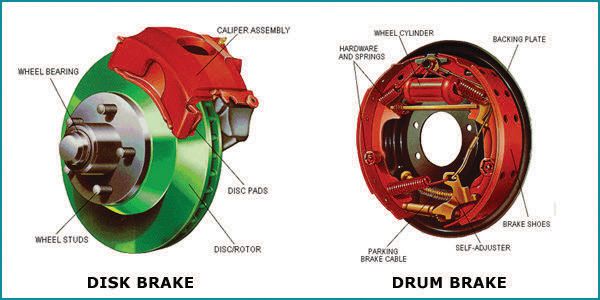 Figure 1. Disc and Drum Brake (Courtesy of Motorist Assurance Program)
Figure 1. Disc and Drum Brake (Courtesy of Motorist Assurance Program)
HAND/PARKING BRAKES
In addition to the hydraulic braking system, all cars have a non-hydraulic mechanical hand (or foot) brake acting on two wheels, usually the rear ones. Theoretically, the hand brake provides limited braking if the rest of the system goes out completely, but it mainly functions as a parking brake. Thus, calling it an emergency brake would be a stretch.
The parking brake lever pulls cables linked to the brakes. A ratchet on the handbrake lever keeps the brake in play until it is released. On drum brakes, the handbrake system simply presses the brake linings against the drums. With disc brakes, because it’s complex to place the linkage on a compact caliper, there is usually a completely separate set of handbrake pads for each disc—making a vehicle with disc brakes on all four wheels a little more expensive than one with drum brakes in the back.
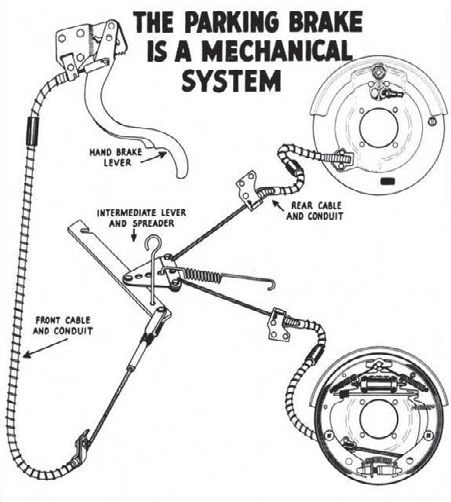 Figure 2. Parking Brake schematic
ANTILOCK BRAKE SYSTEMS (ABS)
Figure 2. Parking Brake schematic
ANTILOCK BRAKE SYSTEMS (ABS)
Antilock brakes were first developed for airplanes in 1929 by French automobile and aircraft pioneer Gabriel Voisin. The first fully electronic ABS was developed in the late’ 60s for the Concorde airplane. In 1971, Chrysler and the Bendix Corp. introduced a computerized, 3-channel, 4-sensor allwheel ABS called
Sure Brake for its 1971 Imperial. The rest is automotive history.
The ABS system, consisting of an electronic control unit, hydraulic actuator and wheel speed sensors, monitors the speed of each wheel with a computer. When it senses that one or more wheels are turning much slower than the others or have stopped, the computer sends a signal to momentarily pulse the pressure to the affected wheel(s) at up to 50 times a second. This allows them to continue turning. When the ABS system is engaged, the driver will feel the pedal pulsing.
Under heavy braking, so much weight may come off the rear wheels that they lock, creating the potential for a dangerous skid (for this reason, the rear brakes are deliberately made less powerful than the front). The most efficient braking force takes place just before each wheel locks up. When the driver slams on the brake and the wheels lock up, steering control is lost (along with the ability to maneuver around the obstacle that necessitated the sudden stop in the first place).
Antilock brake systems solve this lock-up problem by rapidly pumping the brakes whenever the system detects the propensity for a locked wheel. In most cases, it will only pump the locked wheel, maintaining full braking pressure to the other wheels. This gives drivers the ability to brake in the shortest possible time while maintaining full steering control.
True explains, “The introduction of ABS and ESC (electronic stability control) are most impactful to the master cylinder design; the master cylinder must remain robust for life against rapid pressure oscillations which can deteriorate seals. In some cases, the master cylinder must also be designed to allow high fluid flow from the reservoir to the hydraulic pump. This allows the pump to build pressure actively (without operator input) and enables features affecting function or enhancing stability. Traditional limits on hydro-mechanical brake sizing can be overcome with ABS/ESC systems. This can be done by offering more braking power with wheel brakes and managing equilibrium via the electronic control unit and hydraulic actuator.”
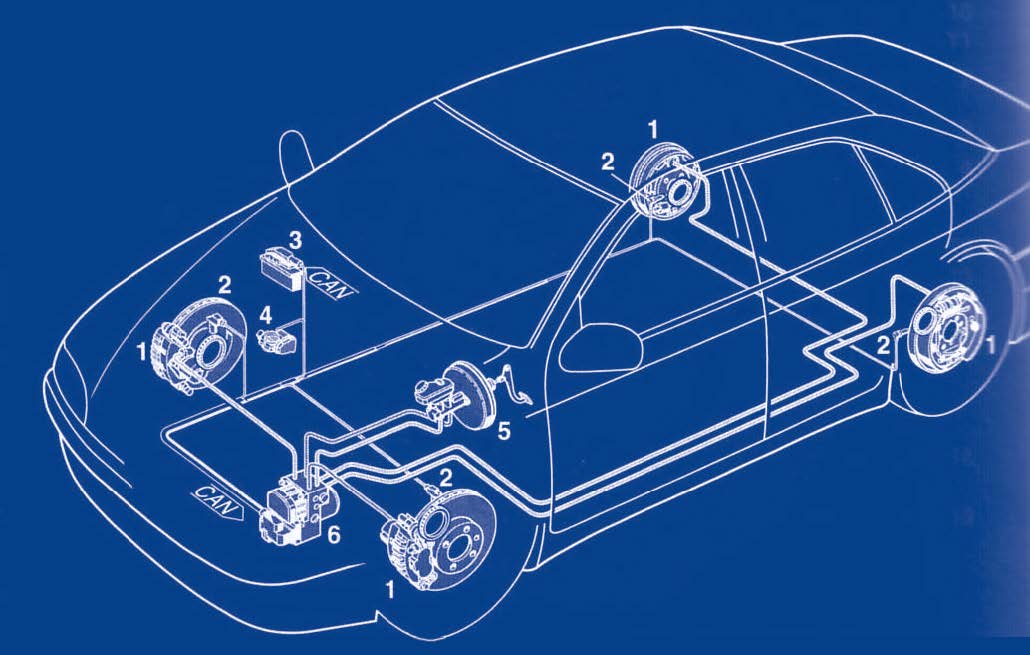 Figure 3. Diagram of a brake system with ABS. (1) Wheel brakes, (2) Wheel-speed sensors, (3)
Figure 3. Diagram of a brake system with ABS. (1) Wheel brakes, (2) Wheel-speed sensors, (3)
Engine ECU, (4) Throttle valve, (5) Brake booster with brake master cylinder, (6) Hydraulic unit
with add-on ECU. (Courtesy of Bosch Automotive Handbook, 8th Edition)
THE MASTER CYLINDER
Most of today’s car brake systems are split into two circuits with two wheels on each circuit. The master cylinder, essentially two completely separate master cylinders in a single housing, supplies pressure to both circuits. If there is a fluid leak in one circuit, only two of the wheels will lose their brakes and the brake pedal will still stop the car.
The master cylinder is located in the engine compartment on the firewall, directly in front of the driver’s seat. Master cylinders have become very reliable and rarely malfunction. But even if there is an internal leak, causing the brake pedal to sink to the floor, releasing the pedal and stepping on it again will bring the pedal (and system) back to life.
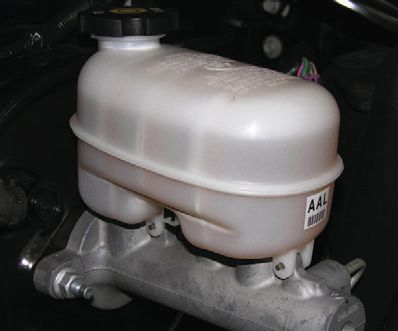
BRAKE FLUID
Brake fluids have stringent performance demands. Not only must they perform across a wide range of temperatures, they must also last a long time—in some cases fill-for-life. In order for the braking system to perform well, brake fluids need to have certain properties and meet certain quality standards.
Boiling point. Brake fluid must perform in cold temperatures without thickening and in high temperatures without boiling. Boiling is especially ominous since it creates air in the system, which is highly compressible relative to liquid. Brake fluid in the wheel cylinders of drum brakes and the calipers of disc brakes is most prone to overheating. In addition to this dry boiling point, standards also address the
wet boiling point, the fluid’s boiling point after absorbing a certain amount of moisture. It’s a single-digit percentage that varies between formulations.
Viscosity. For a brake system to operate reliably, brake fluid must maintain a constant viscosity across a wide range of temperatures. This is especially important in vehicles with ABS and/or ESC because these systems may have a valve that relies on time, rather than pressure, to calibrate the amount of fluid in the system.
Corrosion Resistance. Brake fluids should avoid corroding component metals. In addition, they need to provide as much corrosion protection as possible against any moisture that invades the system. Corrosion inhibitors can provide this protection.
COMPRESSIBILITY
Brake fluids also must maintain a low level of compressibility across a wide range of temperatures. When compressibility drops off, it takes more pressure on the brake pedal to slow or stop the vehicle.
The brake fluid reservoir is on top of the master cylinder. When fresh, all brake fluids are virtually incompressible, and the system works as well as its design. Down the line, brake fluid can become contaminated, leak and boil, producing air bubbles that severely compromise braking ability. The brake fluid level naturally drops slightly as the brake pads wear. But if the level drops noticeably over a short period of time, that is cause for concern.
Gabriel Knee, Dow Corning’s North America automotive market leader in Midland, Mich., explains, “There are really two major types of brake fluid in use today, glycol and silicone. Of these, glycol is far more prevalent and used in most personal vehicles as an OEM filled fluid. Glycol is less expensive and for most vehicles, sufficient for the need.”
AIR BRAKES
Hydraulic brakes use compressed liquid to engage the brakes, while air brakes use compressed air. Air brakes are most often used to stop large heavy vehicles, not passenger cars where compressed air would be so powerful that it would overwhelm the brake system.
The typical air brake system consists of a supply system and a control system. The air compressor draws in air from the outside, compresses it and sends it to the air drier, which removes moisture and impurities and sends the compressed air to the reservoirs. When the brakes are activated, the control system sends the compressed air to the wheel cylinders, activating the brakes.
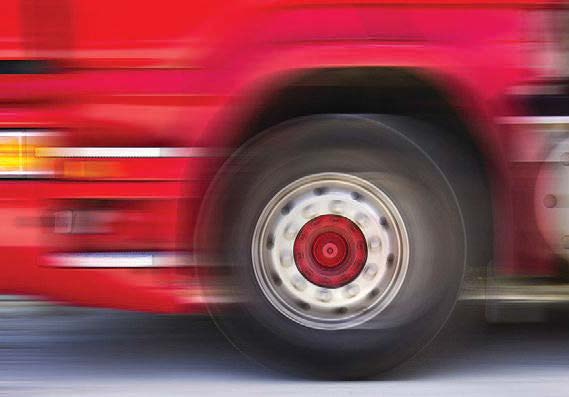
BRAKE FLUID RATINGS
Brake fluid is a non-compressible medium that transmits brake pedal pressure to the master cylinder to calipers to brake pads to discs. Most brake fluid sold in the U.S. is classified and rated by the U.S. Department of Transportation (DOT): DOT 3, DOT 4, DOT 5 and DOT 5.1. Brake fluids are classified by both dry boiling point and wet boiling point. The classifications take SAE’s specifications into account but also consider regional requirements such as typical operating temperatures.
DOT 3. DOT 3 fluids have a minimum dry boiling point (measured with 0 percent water by volume) of 401 F and a minimum wet boiling point (measured with 3.7 percent water by volume) of 284 F. There are no other significant performance requirements. DOT 3 fluids are usually (but not required to be) glycol ether-based, simply because the brake fluid industry has concluded that glycol ether is the most economical way to meet the specifications.
DOT 4. DOT 4 fluids are also glycol ether-based but have borate esters added to improve properties such as increased dry and wet boiling points. DOT 4 fluids must have a minimum dry boiling point of 446 F and a minimum wet boiling point of 311 F. DOT 4 is the fluid of choice for most race engines for a number of reasons, including viscosity. But since the wet and dry boiling points are minimums, Dot 4 is not necessarily better than DOT 3 (some DOT 3 fluids have higher boiling points than some DOT 4 fluids). The main difference between DOT 4 and DOT 3 is that, because it absorbs water more quickly and the effects of water contamination are more serious, DOT 4 needs to be changed more often (
3).
DOT 5. DOT 5 fluids must have a minimum dry boiling point of 500 F and a minimum wet boiling point of 356 F. The original DOT 5 fluid specifications were designed for silicone based fluids because of their resistance to water absorption and compatibility with paint finishes. The problem is that in order to achieve these properties, the fluid had an unacceptably high level of compressibility.
“Silicone does have some advantages,” Knee says. “First, silicone brake fluid has a more stable viscosity index over high and low temperatures. This has advantages for vehicles operating in cold environments and those that are subject to extreme braking, for example those that run in mountainous areas. Over time glycol absorbs moisture, and its performance relative to temperature drops, but silicone is hydrophobic and maintains a stable performance level over long periods of time. Water absorbed by glycol is corrosive to the braking system.”
DOT 5.1. DOT 5.1 was developed as a non-silicone-based fluid to meet DOT 5 wet (500 F) and dry (356 F) boiling point specifications and viscosity requirements. Again, these boiling points are minimums. In actuality, there are no DOT 5.1 brake fluids that exceed the dry and wet boiling points of the best currently available DOT 4 racing brake fluid.
The takeaway is to pay more attention to dry and wet boiling points and VI than DOT grade when selecting a brake fluid.
Table 1. DOT Brake Fluid Properties (Courtesy of Dixcel Advanced Brake Technology)
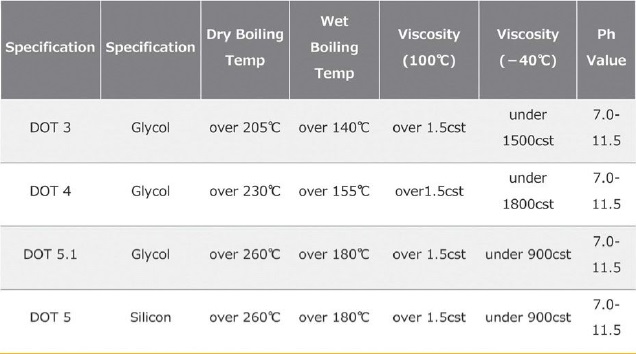
FEDERAL-MOGUL’S TESTS ON BRAKE LINING MATERIALS
Federal-Mogul conducts three levels of tests on brake lining material: physical analysis, dynamometer performance testing and actual on-vehicle validation. Physical analysis determines the various properties of each friction material such as its density and how they can use that characteristic to enhance overall performance. They also determine hardness, compressibility and copper content.
Dynamometer testing shows how the material responds to a variety of operating conditions. Federal-Mogul uses four types of dynamometer testing: AK Master test, SAE J2784 performance test, SAE J2521 noise test and a test known as LA City Simulation, which monitors pad and rotor wear in a challenging urban operating environment like Los Angeles.
The final testing level involves observing the material on vehicles to see how it works in real-world conditions. On-vehicle tests include FMVSS 135 (an OEM stopping distance test for North America), and the European equivalent, R90.
Federal-Mogul also conducts city traffic durability and noise testing, which involves outfitting vehicles with data-collection devices and microphones to determine wear and heat of rotors, noise characteristics and overall braking performance. Additionally, the company conducts fleet testing on a wide range of real-world driving conditions, including snow, ice, high temperatures, stop-and-go driving and operation in mountainous areas.
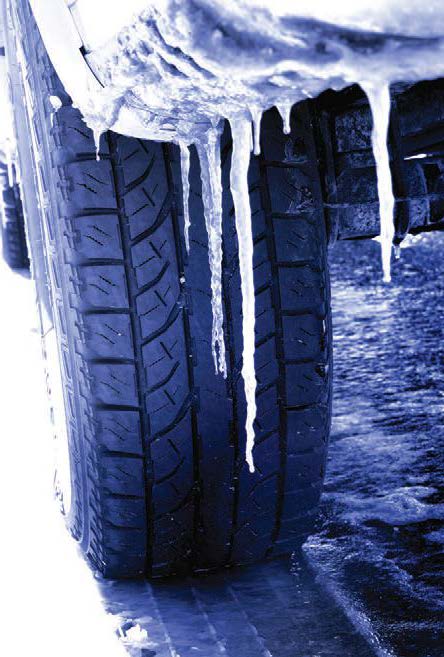
BRAKE LININGS
A critical aspect of any brake system is the wear rate of the braking material, which determines the maintenance interval and the useful life of the components. Two main factors determine brake wear:
1. Component Materials. Brake materials vary considerably—from the type of steel to surface treatments to the type of composites used for brake linings.
2. Temperature. While elevated braking temperatures always increase wear rates, temperature becomes a significant wear factor around 750 F.
The stopping power of brake pads arises from friction, and the longevity of the system depends on the wear resistance of the material used to make the pads or shoes. In a disc brake, there are two brake pads on each caliper (one on each side of the rotor) consisting of a metal shoe with a riveted or bonded lining.
Brake pads wear out and must be replaced. The differences in brake pads affect both brake life and noise. While harder (semimetallic) linings last longer and stop better, they can produce a squeal. The squeal is the result of vibration in the brake pads, which can have a number of causes in addition to the material itself.
Brakes pads are literally under a lot of pressure to perform; they need to accomplish all of the following:
•
Have a consistent amount of bite
•
Perform without compromise across a wide temperature range
•
Minimize the amount of particulate matter they deposit on brake system parts and wheels
•
Be water-resistant in order to maintain structure but also in terms of performance during rain and snow conditions
•
Operate as quietly as possible
•
Maintain their structural integrity in the presence of extremely high friction
•
Be as durable as possible.
All brake pads are made of five basic types of materials: binders, abrasives, performance enhancers, fillers and structural materials that ensure the pad retains its shape. Within these categories are more than 2,000 different substances that create proprietary brake pad formulations.
MATERIALS
Peter Murnen, global marketing director, Aftermarket Braking Federal-Mogul Vehicles Components Segment in Southfield, Mich., explains, “We use low-steel formulations primarily in Europe to address the increased highspeed stopping power requirements and initial bite that’s preferred by many European drivers. Semimetallic and ceramic/NAOs are predominantly used in North America and Asia.”
He adds, “Semimetallic formulas are declining in use overall but typically offer excellent heat management and durability. They are commonly used in severe-duty applications where durability is more important than quiet performance.”
Even though they may be labeled organic or metallic, most brake pads are a mixture of organic and metal materials. Following are key features of primary categories (
4):
Ceramic Pads
•
Ceramic semimetallic pads are today’s industry standard— more than half of all new passenger vehicles come equipped with these pads.
•
They have excellent performance characteristics and are quiet, long-lasting and effective at most temperatures.
•
They are the most expensive option available.
Semimetallic Pads
•
They offer a good compromise between wear resistance, noise and performance.
•
They are more expensive than metallic and organic pads.
•
Often found on new vehicles, they are also an aftermarket pad.
Metallic Pads
•
They offer increased wear resistance.
•
They perform better than other pads at high temperatures.
•
They are very likely to make noise.
Organic Pads
•
They wear more quickly, especially in race cars.
•
They are quiet.
•
They perform better at lower temperatures.
•
They can decompose (and smell) at high temperatures and lose their braking ability.
THE BIRTH OF HYRAULIC BRAKES (5)
In 1900, Fred Duesenberg added a small gasoline engine to a bicycle, and along with his brother, Augie, started building race cars. After World War I, they decided to produce a luxury car with the straight 8-cylinder engine they had developed for their race cars. But they knew that their car—which could top 100 mph—would be too fast for the rearwheel brakes available at the time. Burned-out brake linings were a constant headache for motorists, and stopping distances were hazardously long.
The Duesenbergs decided to adapt the Lockheed hydraulic brakes they had used on a 1914 race car. When the motorist pressed the brake pedal, a piston would force fluid out of a master cylinder into the four brake lines. To increase pressure, a second booster piston would feed extra fluid into the brake lines. The fluid would surge into cylinders in each of four brake drums, which transmitted the pressure to the brake shoes.
The production car equipped with the new brakes was introduced late in 1921, but only a few vehicles were produced. Rivals claimed cars equipped with front brakes would spin out or even overturn during panic stops. In 1922, production totaled 149 Duesenberg Straight 8s. Depending on the body style, the Straight 8 was priced from $6,500 to $8,800, ranking it as a world-class luxury car.
Despite the Straight 8’s superior performance, its styling was too stodgy for the Roaring Twenties. Sales peaked in 1923 at 140 units; only 500 were sold during the car’s entire production run. The company eventually went bankrupt. However, the Duesenbergs’ introduction of hydraulic brakes continues to outlive the company.
“The overwhelming trend at the OEM level for light vehicles has been toward ceramic/NAOs, which now make up 60 to 70 percent of the OEM market,” Murnen says. “Ceramic formulas are designed to be very quiet and offer smooth, comfortable braking, so they don’t give you that hard initial bite—like low steel. Ceramics are also easier on the rotors, which means they don’t create as much dust as low steel and semimetallic formulations. Minimizing brake dust—and the resulting discoloration of wheels— is a strong consumer preference in North America and also in Asia but much less so in Europe.”
Brake pads should be checked at all routine maintenance intervals. If the lining wears through to the metal brake shoe, the metal shoe will come in direct contact with the metal rotor. If this happens, expensive parts start to destruct, braking power starts to diminish, and the squeal morphs into a skin-crawling grinding sound. Some brake pads come with a brake warning sensor that emits a squealing noise when the pads are worn to the point where they need to be changed, others will trigger a dashboard warning light.
“Most advances are happening in the ceramic category,” Murnen says. “In the past few years, OEMs and leading suppliers like Federal-Mogul have focused on developing ceramic formulations for heavier automotive applications in North America such as fullsize pickups. The OEMs want to use ceramics in place of semimetallics so they can offer the automotive-style ceramic braking feel on a larger vehicle.”
He adds, “Another very significant advance is the elimination of copper in ceramic formulations, which is a tough challenge. Copper is a key abrasive in conventional ceramic formulations, but legislation in California and Washington State requires the use of lowcopper brake pads by 2021 and no copper brake pads by 2025. Federal- Mogul and its Wagner brand have accomplished both.”
So how long should auto brake pads last? Murnen advises that original equipment brake pads for the North American market are designed to last around 30,000 to 35,000 miles. Premium (not all) aftermarket brake pads are engineered to last as long as the original pads. “Keep in mind that the life of brake pads also varies by driver, road condition and even geography,” he says. “If your brakes are making noise, you need to have them checked.”
So can brakes suddenly go out? Yes, for one or more of the following reasons:
•
One of the rotors cracked or shattered (probably from too much heat), and the pads are essentially pressing against each other instead of the rotor.
•
The pads become soaked with water, rendering them ineffective (not an issue with ceramic or metallic brake pads).
•
The brake pads weren’t installed correctly.
•
The lining wears completely down, and the rotor becomes hopelessly warped.
•
A caliper locks up.
•
Something, including the pedal, becomes disconnected from the rest of the braking system.
•
The brake pads overheat and experience fade or loss of braking power.
Then there’s the possibility of a cyber attack…
REFERENCES
1.
Cars have electronic control units (ECUs) that rely on computer code to manage critical interconnected systems. They have the same wireless technology (and same vulnerabilities) as cell phones.
2.
From: click
here.
3.
DOT 4 fluid will initially have a more stable and higher boiling point, but once the fluid begins to absorb water its boiling point will fall off more rapidly than a DOT 3.
4.
From: click
here.
5.
From: click
here.
 Jeanna Van Rensselar heads her own communications firm, Smart PR Communications, in Naperville, Ill. You can reach her a
Jeanna Van Rensselar heads her own communications firm, Smart PR Communications, in Naperville, Ill. You can reach her at
jeanna@smartprcommunications.com.